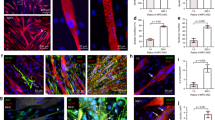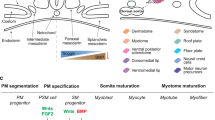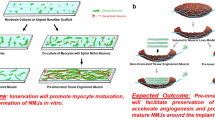Abstract
Bone can be engineered in vivo by implantation of gene-activated muscle tissue fragments. This expedited approach may be further improved by use of muscle tissue with attached fascia. The aim of this in vitro study was to provide an in depth comparison of the osteogenic differentiation capacity of muscle alone and muscle with fascia after BMP-2 transduction. Skeletal muscle tissue from rats was cut into pieces with and without a fascia layer on the surface. Adenoviral BMP-2 or GFP vectors were used for transduction. Osteogenic differentiation within the tissue fragments was evaluated and compared by qRT-PCR, alizarin red S staining, histomorphometry and immunohistology. Transduction efficiency and level of transgene expression were higher for muscle with fascia than muscle alone. Transduction with BMP-2 led to a significant upregulation of bone marker genes, proteins, and calcium deposition in both groups. Interestingly, histological evaluation revealed that osteoinduction did not occur within the fascia layer itself. The upregulation of bone marker genes in muscle with fascia was significantly lower after 2 weeks but similar after 4 weeks of in vitro culture in comparison to muscle alone. The fascia layer led to higher transduction efficiency and enhanced BMP-2 expression. Despite fascia’s lower capacity for osteogenic differentiation, muscle implants may benefit from the fascia layer by the improved ability to deliver BMP-2. The presented data may contribute to the development of a novel, cost-effective, single-surgery bone engineering technology and encourage the evaluation of the osteoregenerative potential of muscle with fascia in an animal model.
This is a preview of subscription content, access via your institution
Access options
Subscribe to this journal
Receive 12 print issues and online access
$259.00 per year
only $21.58 per issue
Buy this article
- Purchase on Springer Link
- Instant access to full article PDF
Prices may be subject to local taxes which are calculated during checkout








Similar content being viewed by others
References
Schacter GI, Leslie WD. Diabetes and bone disease. Endocrinol Metab Clin North Am. 2017;46:63–85.
Mills LA, Aitken SA, Simpson A. The risk of non-union per fracture: current myths and revised figures from a population of over 4 million adults. Acta Orthop. 2017;88:434–9.
Rajaee SS, Kanim LE, Bae HW. National trends in revision spinal fusion in the USA: patient characteristics and complications. Bone Jt J. 2014;96-B:807–16.
Kneser U, Schaefer DJ, Polykandriotis E, Horch RE. Tissue engineering of bone: the reconstructive surgeon’s point of view. J Cell Mol Med. 2006;10:7–19.
Jung T, Lee JH, Park S, Kim YJ, Seo J, Shim HE, et al. Effect of BMP-2 delivery mode on osteogenic differentiation of stem cells. Stem Cells Int. 2017;2017:7859184.
Aslan H, Zilberman Y, Kandel L, Liebergall M, Oskouian RJ, Gazit D, et al. Osteogenic differentiation of noncultured immunoisolated bone marrow-derived CD105+cells. Stem Cells. 2006;24:1728–37.
Virk MS, Sugiyama O, Park SH, Gambhir SS, Adams DJ, Drissi H, et al. “Same day” ex-vivo regional gene therapy: a novel strategy to enhance bone repair. Mol Ther. 2011;19:960–8.
Betz VM, Betz OB, Harris MB, Vrahas MS, Evans CH. Bone tissue engineering and repair by gene therapy. Front Biosci. 2008;13:833–41.
Betz OB, Betz VM, Abdulazim A, Penzkofer R, Schmitt B, Schroder C, et al. Healing of large segmental bone defects induced by expedited bone morphogenetic protein-2 gene-activated, syngeneic muscle grafts. Hum Gene Ther. 2009;20:1589–96.
Betz OB, Betz VM, Abdulazim A, Penzkofer R, Schmitt B, Schroder C, et al. The repair of critical-sized bone defects using expedited, autologous BMP-2 gene-activated fat implants. Tissue Eng Part A. 2010;16:1093–101.
Betz OB, Betz VM, Schroder C, Penzkofer R, Gottlinger M, Mayer-Wagner S, et al. Repair of large segmental bone defects: BMP-2 gene activated muscle grafts vs. autologous bone grafting. BMC Biotechnol. 2013;13:65.
Bhattacharya V, Barooah PS, Nag TC, Chaudhuri GR, Bhattacharya S. Detail microscopic analysis of deep fascia of lower limb and its surgical implication. Indian J Plast Surg. 2010;43:135–40.
Stecco A, Masiero S, Macchi V, Stecco C, Porzionato A, De Caro R. The pectoral fascia: anatomical and histological study. J Bodyw Mov Ther. 2009;13:255–61.
Betz VM, Betz OB, Rosin T, Keller A, Thirion C, Salomon M, et al. The effect of BMP-7 gene activated muscle tissue implants on the repair of large segmental bone defects. Injury. 2015;46:2351–8.
Li G, Zheng B, Meszaros LB, Vella JB, Usas A, Matsumoto T, et al. Identification and characterization of chondrogenic progenitor cells in the fascia of postnatal skeletal muscle. J Mol Cell Biol. 2011;3:369–77.
Kim HL, LaBarbera MC, Patel RV, Cromie WJ, Bales GT. Comparison of the durability of cadaveric and autologous fascia using an in vivo model. Urology. 2001;58:800–4.
Lee MG, Kim JS, Lee DC, Roh SY, Lee KJ, Choi BK. Fascial free flap for reconstruction of the dorsolateral hand and digits: the advantage of a thin contour. Arch Plast Surg. 2016;43:551–8.
Nuri T, Ueda K, Yamada A. Application of free serratus anterior fascial flap for reconstruction of ear deformity due to hemifacial microsomia: a report of two cases. Microsurgery 2017;37(5):436-441.
Veyrat M, Verillaud B, Herman P, Bresson D. How I do it. The pedicled temporoparietal fascia flap for skull base reconstruction after endonasal endoscopic approaches. Acta Neurochir. 2016;158:2291–4.
Kaplan FS, Pignolo RJ, Al Mukaddam MM, Shore EM. Hard targets for a second skeleton: therapeutic horizons for fibrodysplasia ossificans progressiva (FOP). Expert Opin Orphan Drugs. 2017;5:291–4.
Kaplan FS, Seemann P, Haupt J, Xu M, Lounev VY, Mullins M, et al. Investigations of activated ACVR1/ALK2, a bone morphogenetic protein type I receptor, that causes fibrodysplasia ossificans progressiva. Methods Enzymol. 2010;484:357–73.
Baltzer AW, Lattermann C, Whalen JD, Braunstein S, Robbins PD, Evans CH. A gene therapy approach to accelerating bone healing. Evaluation of gene expression in a New Zealand white rabbit model. Knee Surg Sports Traumatol Arthrosc. 1999;7:197–202.
Bosch P, Musgrave DS, Lee JY, Cummins J, Shuler T, Ghivizzani TC, et al. Osteoprogenitor cells within skeletal muscle. J Orthop Res. 2000;18:933–44.
Shen HC, Peng H, Usas A, Gearhart B, Fu FH, Huard J. Structural and functional healing of critical-size segmental bone defects by transduced muscle-derived cells expressing BMP4. J Gene Med. 2004;6:984–91.
Lee JY, Peng H, Usas A, Musgrave D, Cummins J, Pelinkovic D, et al. Enhancement of bone healing based on ex vivo gene therapy using human muscle-derived cells expressing bone morphogenetic protein 2. Hum Gene Ther. 2002;13:1201–11.
Peng H, Usas A, Olshanski A, Ho AM, Gearhart B, Cooper GM, et al. VEGF improves, whereas sFlt1 inhibits, BMP2-induced bone formation and bone healing through modulation of angiogenesis. J Bone Miner Res. 2005;20:2017–27.
Irie K, Ejiri S, Sakakura Y, Shibui T, Yajima T. Matrix mineralization as a trigger for osteocyte maturation. J Histochem Cytochem. 2008;56:561–7.
Wong HL, Siu WS, Fung CH, Zhang C, Shum WT, Zhou XL, et al. Characteristics of stem cells derived from rat fascia: in vitro proliferative and multilineage potential assessment. Mol Med Rep. 2015;11:1982–90.
James AW, LaChaud G, Shen J, Asatrian G, Nguyen V, Zhang X, et al. A review of the clinical side effects of bone morphogenetic protein-2. Tissue Eng Part B Rev. 2016;22:284–97.
Acknowledgements
This work was supported by the Friedrich-Baur-Foundation (LITE:P). BR received a fellowship from the china scholarship council (CSC) (No. 201406270144). The study sponsors did not influence the study design, the collection, analysis, and interpretation of data, the writing of the report or the decision to submit the paper for publication.
Author information
Authors and Affiliations
Corresponding author
Ethics declarations
Conflict of interest
CT and MS are shareholders of Sirion Biotech GmbH. Sirion Biotech GmbH produced the adenoviral vectors used in this study. All the remaining authors declare that they have no conflict of interest.
Rights and permissions
About this article
Cite this article
Ren, B., Betz, V.M., Thirion, C. et al. Osteoinduction within BMP-2 transduced muscle tissue fragments with and without a fascia layer: implications for bone tissue engineering. Gene Ther 26, 16–28 (2019). https://doi.org/10.1038/s41434-018-0047-2
Received:
Revised:
Accepted:
Published:
Issue Date:
DOI: https://doi.org/10.1038/s41434-018-0047-2



